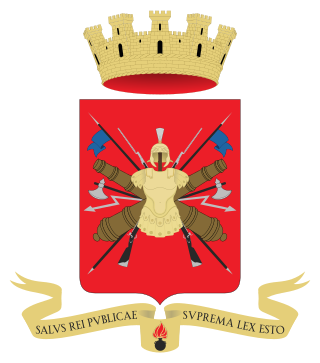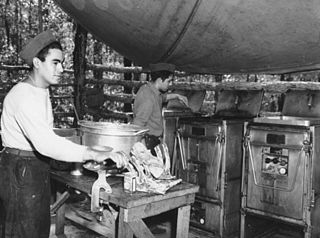External links
Rations of the United States military | |||||
|---|---|---|---|---|---|
| Historical rations | |||||
| Current rations |
| ||||
| Misc. | |||||
The Mountain Ration (or "M-Ration") was a United States military ration developed for use by U.S. troops operating in high-altitude or mountainous regions of the European theatre of World War II.
The components of what would become the Mountain ration were developed in 1941–42 by U.S. Army officers in experimental mountain warfare companies, largely consisting of former ski instructors, forest rangers, and other experienced alpine travelers. Based on their recommendations, the Mountain ration was finalized and packaged for use by mountain and alpine troops by personnel at the Quartermaster Corps' Subsistence Research Laboratory in Chicago, Illinois.
In order to make the rations suitable for high-altitude climates, the Mountain ration was designed as a specialized compact ration that was easier to prepare in high-altitude environments, have adequate roughage, and enough bulk and quantity when heated to satisfy four men in one day at high altitude, weigh less than 40 ounces (1,100 g), and contain a total of 4,800 kilocalories (20,000 kilojoules) per man per day. The ration was formally adopted in November 1942. [1]
The Mountain ration was produced from 1942 to 1943, and issued to soldiers of several elite U.S. and British Commonwealth forces then in training for alpine or winter combat, especially the 10th Mountain Division, and the First Special Service Force. As packaged, the Mountain ration was sized to serve four men for one day (three meals per man). It was normally prepared at the platoon or squad level, though 10th Division troopers were also taught to prepare it individually. [2] The 1st Special Service Force first tried out the Mountain ration on November 28, 1942, during a training patrol to MacDonald Pass, Montana:
"At 1400 hours all company commanders and one other officer from each company and a few others left by truck for MacDonald Pass to try living under winter conditions and try a new mountain ration ... On arrival at the selected spot the party broke up into groups of four and built shelters and fires of many different types. The Mountain ration, which comes in four varieties, is packed in boxes, each box containing the rations of 4 men for 3 meals, this proved to be more than the average man could eat. They included powdered soup and milk, canned meat and butter, cereal, chocolate, biscuits, compressed fruits, sugar, tea and coffee and powdered lemon." [3]
Because of its generous portions, specialization, and significantly higher cost, the Mountain ration was intensely disliked [4] by the Quartermaster Command, headed by Quartermaster General Edmund B. Gregory, whose organization had to procure, store, and ship it. [5] To bolster their argument, Quartermaster Corps and Subsistence Branch staff heavily criticized the Mountain ration for its weight, although for its caloric content a day's ration was lighter than alternative canned C rations, and it had nearly 2,000 kilocalories (8,400 kJ) more than the K ration.
The Mountain ration was also criticized for its involved preparation times; the Mountain ration required heating, which was difficult to accomplish for ordinary infantry soldiers without individual or squad-level cooking stoves, though this did not affect mountain troops such as the 10th Mountain Division, who had such equipment. In common with the alpine troops of other countries, the 10th's officers recognized the distinct benefits of heated, easily digested foods at high altitudes. However, the noise and bulk of heating equipment and additional cooking utensils was disliked by some 10th Mountain troopers, who viewed the mountain ration as better suited to bivouac areas or mountain strongholds not subject to sudden enemy assault. [6] Significantly, diagnosed cases of malnourishment and vitamin deficiency, which had been reported among other light infantry units of the U.S. Army in the ETO who had been forced to consume the K ration for extended periods of time, did not arise among troops of the 10th Mountain Division, who received a wider variety of food rations including the Mountain ration, K ration, C ration, and 10-in-1 group ration while in the field. [7]
By early 1943, less than three months after adoption, the Quartermaster Corps' Food Services Branch was already requesting the Army to abolish all non-standard lightweight individual rations except for the K and D rations. [8] To the immense relief of the Quartermaster Corps's Food Services branch, [8] the Mountain ration was discontinued and production terminated in 1943, [9] though supplies continued to be issued well into 1944. The 10th Mountain Division, which was issued the ration while in training, did not deploy to combat until January 1945; in the last months of the war, with supplies of the Mountain ration exhausted, most of the 10th's troopers serving in combat were issued the K ration, the C ration, or the 10-in-1 ration.
At war's end, after the shortcomings of the C ration (monotony and weight) and the K ration (malnourishment and vitamin deficiency) had become apparent, [10] the Quartermaster Corps attempted to shift responsibility for individual ration inadequacies. Contravening their earlier statements, the QC now asserted that overuse of the K and C rations (beyond two or three days) had caused the problem. [11] [12] Having successfully obtained the discontinuance of suitable alternative packaged rations, the QMC's Historical Summary report was conspicuously silent on how Army commanders could have observed this new ration restriction for troops in daily contact with a determined enemy. [13] [14] Surprisingly, even with this new admission, the QC still refused to abandon their prior recommendation for standardization on a single type of canned wet individual ration, a recommendation that was eventually adopted. [15]
At war's end, rather than introduce a new and improved lightweight ration designed for prolonged use, the K ration was itself promptly discontinued (along with the 10-in-1 small group ration, which had proven somewhat useful in boosting nourishment levels for men living for extended periods on C or K rations). Instead, the C ration, still designated for "infrequent use", went through a series of largely unsuccessful minor revisions. [15]
The mountain ration contained:
In addition to the basic components listed, the 10th Mountain Division's officers and NCOs, many with a pre-war background in high altitude and alpine cooking, were known to significantly augment the Mountain ration with a stocked supply of numerous additional ingredients and spices. [6]

A battalion is a military unit, typically consisting of 300 to 1,000 soldiers commanded by a lieutenant colonel, and subdivided into a number of companies. The typical battalion is built from three operational companies, one weapons company and one HQ company. In some countries, battalions are exclusively infantry, while in others battalions are unit-level organisations.

Philippine Division, or from 1946–1947 the 12th Infantry Division, was the core U.S. infantry division of the United States Army's Philippine Department during World War II.

The Meal, Ready-to-Eat (MRE) is a self-contained individual United States military ration used by the United States Armed Forces and Department of Defense (DoD). It is intended for use by American service members in combat or field conditions where other food is not available. MREs have also been distributed to civilians as humanitarian daily rations during natural disasters.

The C-ration was a United States military ration consisting of prepared, canned wet foods. They were intended to be served when fresh or packaged unprepared food was unavailable, and survival rations were insufficient. It was replaced by the similar Meal, Combat, Individual (MCI) in 1958; its modern successor is the Meal, Ready-to-Eat (MRE).
The 10-in-1 food parcel, commonly known as the 10-in-1 ration, was a United States military ration issued during World War II. As its name implies, the 10-in-1 provided the needs of ten soldiers in a single ration package.

United States military ration refers to the military rations provided to sustain United States Armed Forces service members, including field rations and garrison rations, and the military nutrition research conducted in relation to military food. U.S. military rations are often made for quick distribution, preparation, and eating in the field and tend to have long storage times in adverse conditions due to being thickly packaged or shelf-stable.

The K-ration was a United States military ration consisting of three separately boxed meal units: breakfast, dinner, and supper. It was originally intended as an individually packaged daily ration for issue to airborne troops, tank crews, motorcycle couriers, and other mobile forces for short durations.

The Italian Army is the land-based component of the Italian Armed Forces. The army's history dates back to the Italian unification in the 1850s and 1860s. The army fought in colonial engagements in China, Libya, Northern Italy against the Austro-Hungarian Empire during World War I, Abyssinia before World War II and in World War II in Albania, Balkans, North Africa, the Soviet Union, and Italy itself. During the Cold War, the army prepared itself to defend against a Warsaw Pact invasion from the east. Since the end of the Cold War, the army has seen extensive peacekeeping service and combat in Afghanistan and Iraq. Its best-known combat vehicles are the Dardo infantry fighting vehicle, the Centauro tank destroyer and the Ariete tank and among its aircraft the Mangusta attack helicopter, recently deployed in UN missions. The headquarters of the Army General Staff are located in Rome opposite the Quirinal Palace, where the president of Italy resides. The army is an all-volunteer force of active-duty personnel.

A field ration is a type of prepackaged military ration designed to be easily and quickly prepared and consumed in the field, in combat, at the front line, or where eating facilities are otherwise unavailable. Field rations are primarily used by military forces, though they are also sometimes distributed to civilians as part of humanitarian aid and emergency management. They differ from garrison rations and field kitchen provisions, which are intended for where proper meals can be supplied and prepared with relative ease and safety, such as in the rear where logistics are steady and fresh food can be supplied. They are similar to, but distinct from, other purpose-designed long-lasting types of food or rations such as emergency rations, humanitarian daily rations, and camping food.

Military chocolate has been a part of standard United States military rations since the original D-ration bar of 1937. Today, military chocolate is issued to troops as part of basic field rations and sundry packs. Chocolate rations served two purposes: as a morale boost, and as a high-energy, pocket-sized emergency ration. Military chocolate rations are often made in special lots to military specifications for weight, size, and endurance. The majority of chocolate issued to military personnel is produced by The Hershey Company.

A garrison ration is a type of military ration. Usually distinct from field rations, the term has varying meanings, but generally refers to either rations issued to personnel at a camp, installation, or other garrison; allowance allotted to personnel to purchase goods or rations sold in a garrison; the rations purchased with the aforementioned allowance; or a type of issued ration.
The 5-in-1 ration was a United States military ration issued from 1942 to the end of World War II. As its name implies, the 5-in-1 provided the needs of five soldiers in a single ration package. Procurement ended with the war, though remaining stocks were issued to troops after the war, as well as distributed as surplus in civilian feeding programs overseas. The 5-in-1 specification remained in effect after the war, and was again used in 1948 for a new field ration.
The Jungle Ration was a dry, lightweight United States military ration developed by the U.S. Army during World War II for soldiers on extended missions in tropical regions.

Military rations, operational rations, or military provisions are goods issued to sustain the needs of military personnel. As their name suggests, military rations have historically been, and often still are, subject to rationing, with each individual receiving specific amounts from available supplies. Military-issued goods and the rationing of such goods has existed since the beginnings of organized warfare.

The Food Packet, Long Range Patrol was a freeze-dried dehydrated United States military ration used by the United States Armed Forces. Developed in 1964 and intended for wide adoption during the Vietnam War, its use was eventually limited to American special operations forces during long-range reconnaissance patrols, where bulky canned Meal, Combat, Individual (MCI) rations proved too heavy for extended missions on foot. The LRP had a cold-weather warfare equivalent, the Ration, Cold Weather (RCW).

The Meal, Combat, Individual (MCI) was a United States military ration of canned and preserved food, issued from 1958 to 1980. It replaced the earlier C-ration, which it was so similar to that it was often nicknamed the "C-ration", despite the term never being used officially. The MCI was eventually replaced by the Meal, Ready-to-Eat (MRE).

The B-ration was a United States military ration consisting of packaged and preserved food intended to be prepared in field kitchens by cooks. Its modern successor is the Unitized Group Ration – M (UGR-M), which combines multiple types of rations, including the B-ration, under one unified system.

The structure of the United States Army is complex, and can be interpreted in several different ways: active/reserve, operational/administrative, and branches/functional areas.

The history of military nutrition in the United States can be roughly divided into seven historical eras, from the founding of the country to the present day, based on advances in food research technology and methodologies for the improvement of the overall health and nutritional status of U.S. military service members. Through the research and guidance of medical and military professionals, rations and packaging have been consistently and dramatically improved.

The Unitized Group Ration (UGR) is a United States military ration used by the United States Armed Forces and Department of Defense (DoD). It is intended to sustain groups of American service members with access to a field kitchen, serving as a field ration and a garrison ration. It is the modern successor to several older alphabetized rations—namely the A-ration, B-ration, and T-ration—combining them under a single unified system. UGRs are designed to meet the Military Daily Recommended Allowance when averaged over a 5 to 10 day period, with each meal providing between 1,300 and 1,450 kcal.